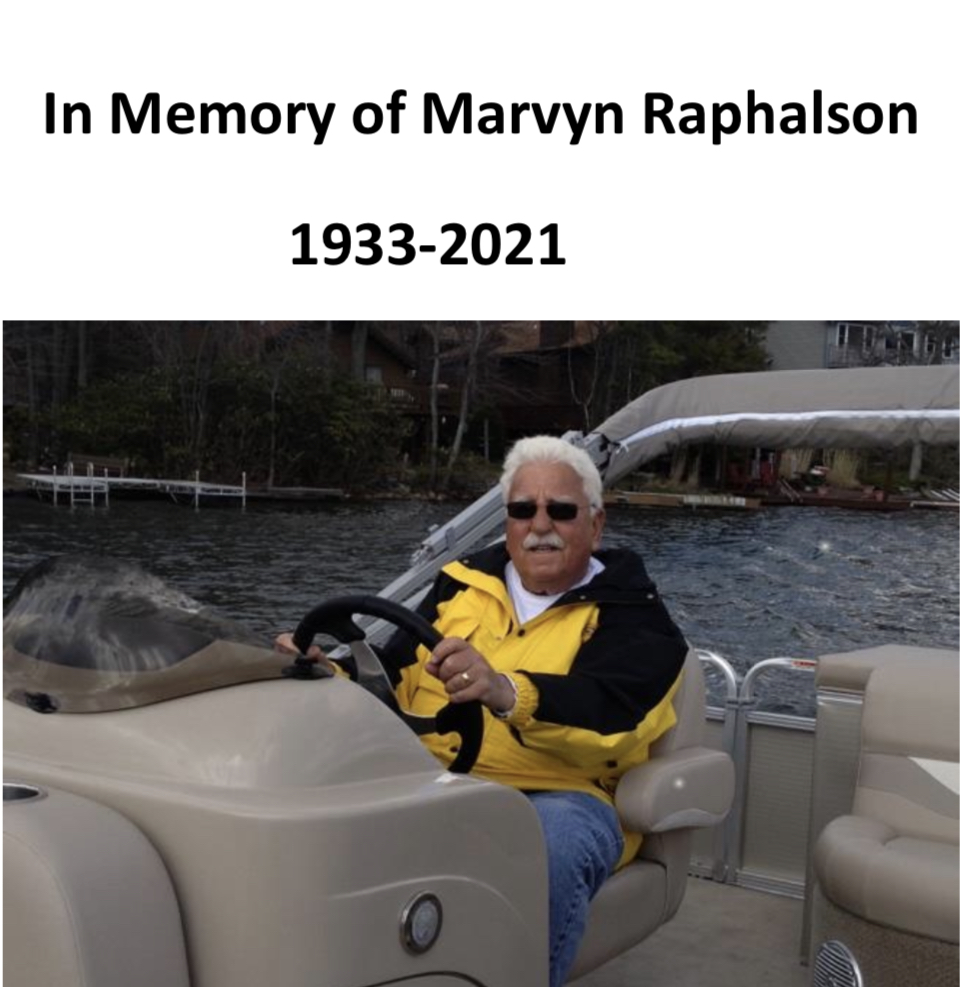
History Of LHWPG
Click to Donate In Memory of Marvyn Raphalson 1933-2021
In Memory of Marvyn Raphalson 1933-2021
LHWPG was founded as “Save the Lake” in 1984 by Marvyn and Ginny Raphaelson. They were motivated by the excessive growth of invasive plants interfering with boating and swimming. Under their leadership, the organization grew to today’s scope and size. Marvyn served as treasurer until 2018, keeping the books, paying the bills, arranging for audits and making sure that taxes were paid on time. He assembled and sent out the annual mailings and wrote all the thank you notes. His enthusiasm and devotion to LHWPG is remembered by all who knew him.
--------------------------------------------------------------------------------------------
Many generations of residents, visitors and community members have utilized Lake Harmony's recreational opportunities. Fishing in the summer or winter, gathering with friends for the day or for a wedding, kayaking, boating, water skiing, or watching the sun set, many enjoy the lake each year. Additionally, a considerable amount of work by volunteers and trained specialists has also taken place concurrent with this enjoyment. Benefits with music, dancing and delicious food donated by the local restaurant owners have raised funds for numerous geological and engineering studies and methods employed to improve lake health. Volunteers have collected leaves, cleaned culverts and repaired the rain gardens which are so vital to prevent sediment from reducing lake depth, volume and water quality. A book has been published and many meetings and discussions have been attended so that Lake Harmony can continue to thrive.
Our history is included to capture these extensive efforts to maintain and improve the overall quality of Lake Harmony. The history is also here for LHWPG to say thank you for being part of the Lake Harmony community, and for doing your part, so we all can continue to actively share in the Lake Harmony treasures.
Early History of Lake Harmony Watershed Preservation Group (formally Lake Harmony Concerned Citizens)
1. Our group began in 1993, realizing the integrity of our water was threatened. It was so obvious that we could tell that the lake we had known was changing before our very eyes. At that time we had no knowledge of lake degradation or water quality management, let alone understanding our local watershed. But we were able to know that this body of water needed help.
2. Our first meeting was held during the summer of 1993 by inviting neighbors and friends to talk about what we had noted.
3. We invited more neighbors to come share their thoughts about the lake and to see if anyone might know what should be done. We began asking questions.
4. We invited groups from other nearby lakes and asked questions.
5. We called Pennsylvania Department of Environmental Protection (PADEP) and found out about a state-sponsored organization called Pennsylvania Lake Management Society (PALMS). We attended one of their conferences and brought back a lot of information and shared it with our group and neighbors.
6. We employed a lake contractor called Echo Science in 1995 to advise us and to do a lake treatment, and we contracted F. X. Brown, Inc. as a consultant.
7. We continued to educate ourselves and share what we were learning at workshops.
8. In 2001, NatureWorks took over Echo Science’s position.
9. We hosted a meeting and showed neighbors how simple plantings along the edge of the lake could help absorb pollutants from rainwater. We gave out grass seed to each person who came. We also gave out purple dye tablets for lake residents to flush into their septic systems, which should show seepage into the lake, if any. This helped in our pursuit of the community sewage system.
10. Pennsylvania Lake Management Systems invited us to speak about our work and community involvement at their conferences beginning in 2000. In 2001 we won two awards:
-Outstanding Watershed Organization Award; and
-Outstanding Individual Award.
11. We realized that identifying Point and Non Point Source Pollution was our next step. We were able to determine rainwater flowing off impervious surfaces and people’s chemically treated yards were harming the ecosystem. We were able to describe the problems and develop an adequate plan to cure the problem areas to DEP and we were awarded a $47,940 grant in 2001. We worked three major sites with this money and we involved and educated local school students, scouts and citizens.
12. We received two $400 Beautification Grants from Pocono Mountain Vacation Bureau.
13. We educated local persons about zebra mussels and distributed flyers to realtors to hand out to renters.
14. Today, we continue to provide scientific education to our community and work with BMP (Best Management Practices). We continue regular monitoring of Lake Harmony and treat as needed. We were able to take a Stage 3 lake, eutrophic category and improve its water quality to mesotrophic classification.
15. Prosser Labs continues to check for fecal coliform count (at its lowest level in our data-collection history).
16. In 2007, we filed for a 501(c)(3) and received another grant for $10,000.
17. In 2008, we changed our name to Lake Harmony Watershed Preservation Group.
As the scientific, educational and community journeys have continued since those days 30+ years ago, presentations, frequently asked questions (FAQs), studies and reports also continue...please follow along below. And don't hesitate to Contact Us or email us at
Clean-Flo Lake Restoration Video Presentation-2017
This presentation was given on February 23, 2017 at the Kidder Township Municipal Building by Brian Kling of Clean-Flo International. It covers the Clean-Flo technology for improving waterbodies with Inversion Oxygenation and Bioaugmentation.
Frequently Asked Questions for Aeration and Bioaugmentation-2017
The FAQs summarize questions and answers completed during the assessments of and decisions to commit to the enhanced treatment of Lake Harmony for its preservation and future health. Review this document to gain more insight about moving the inversion oxidative and vegetative treatment programs forward.
Summary for Aeration and Bioaugmentation-2017
This 16-page report provides detailed scientific analysis concerning the composition and location of organic versus inorganic materials found at the bottom of Lake Harmony.
The purpose of this evaluation was to determine if aeration and bioaugmentation processes would be a viable option to increase the depth and health of Lake Harmony. The data presented in this document is a compilation of data found in the Hanover report dated November 2015 (initiated by the Lake Harmony Watershed Preservation Group), and the core samples of the lake sediments taken at that time.
The Hanover report has a sonar scan which was done by Natureworks in 2013, showing areas of hard and soft bottom and provided an idea of where there was more or less muck. The scale used for measurement at that time was that darker areas had less muck. Clean-Flo was also able to do a scan of the entire lake prior to installing the system, to establish the baseline as it stood in 2017.
The 2015 Hanover report indicated that there was 1,300,000 yd.³ of unconsolidated sediments in the lake. It also indicated that the unconsolidated sediment was slightly greater than 1/2 of the lake’s original water volume. This unconsolidated sediment was a mixture of organic and inorganic materials as well as water. This is the type of typical muck that you step into and sink, and many times smell the hydrogen sulfide. It also contains a massive amount of nutrients to feed weed and algae growth. Getting rid of this muck is the main focus.
Typically, organic muck is roughly 20-60% organic or more, 20-40% water, and 20-40% inorganic material. 1,300,000 yd.³ is equal to 35,100,000 ft.³. At 118 acres, the lake covers 5,140,080 ft.². If the sediment was evenly distributed throughout the lake, the bottom would be covered in 6.83 feet of unconsolidated sediments throughout.
Looking at the maps and charts, it’s not surprising that there is a lot of muck around various docks. The muck can also shift from time to time based on wind and wave action, as well as boat traffic.
This report concluded that Lake Harmony has been and continues to be impacted by sediments and nutrients from the lake’s watershed. The sediments and associated nutrients impact the recreational uses, aesthetics, water quality, and aquatic habitats associated with Lake Harmony. Algae blooms on the lake were increasingly appearing, including cyanobacteria (a.k.a. blue green algae), known to potentially increase dangerous algal toxins that can cause maladies, and can even be fatal for humans, pets and livestock. There was also a notable increase in nuisance aquatic vegetation in areas becoming shallower and contained softer sediments. (Hanover Report, November 2015 page 19).
From the scientific data provided throughout, the 2017 Clean-Flo report stated that the aeration system could reduce over half of the inorganic materials at specific locations, primarily located in the center of the lake. There would be an average of 3.4 foot increase in water column throughout the lake. But it was determined that the sediment was not evenly distributed, with some lake areas having much more sediment than others; in those high sediment areas, it was expected that more than the 3+ foot of increase in water column would occur, which is a significant reduction.
Once plant life is reduced, odors disappear, and water quality gets much better. The Clean-Flo process affects only the organic and water portions of the muck, not the inorganic material. The organic portion keeps the inorganic material suspended in the muck, but once the organic portion is reduced by the process, the inorganic material drops out of the water column to the bottom.
Wrapping up this report, Clean-Flo’s 2017 proposed cost for the project is provided on page 16.
SIS.bio Lake Harmony Sediment Reduction Case Study-2020
In 2017, concern with the reduction in depth of the lake and the increasing invasiveness of the lily pads became so bad that the decision was made to implement an effective solution that would both improve water quality and also digest the accumulated organic sediment, in order to restore depth to the lake, while depriving the invasive lily pads and other invasive growth of a nutrient-rich rooting bed.
This Lake Harmony Case Study explains that a 2017 bathymetric survey (sound waves used to measure the distance between the boat surface and the water bed, with topographic maps produced) was used to propose a solution to restore Lake Harmony water depth and volume, and water quality, The solution was approved and commissioned in June 2018, working with Clean-Flo and Natureworks, using multiple bubblers and an intensive bioaugmentation treatment program to digest the accumulating sediment.
The reports show achieved improvements in water depth, quantity and quality.
Refer to the Reports page for Current Lake Assessments and Reports.
